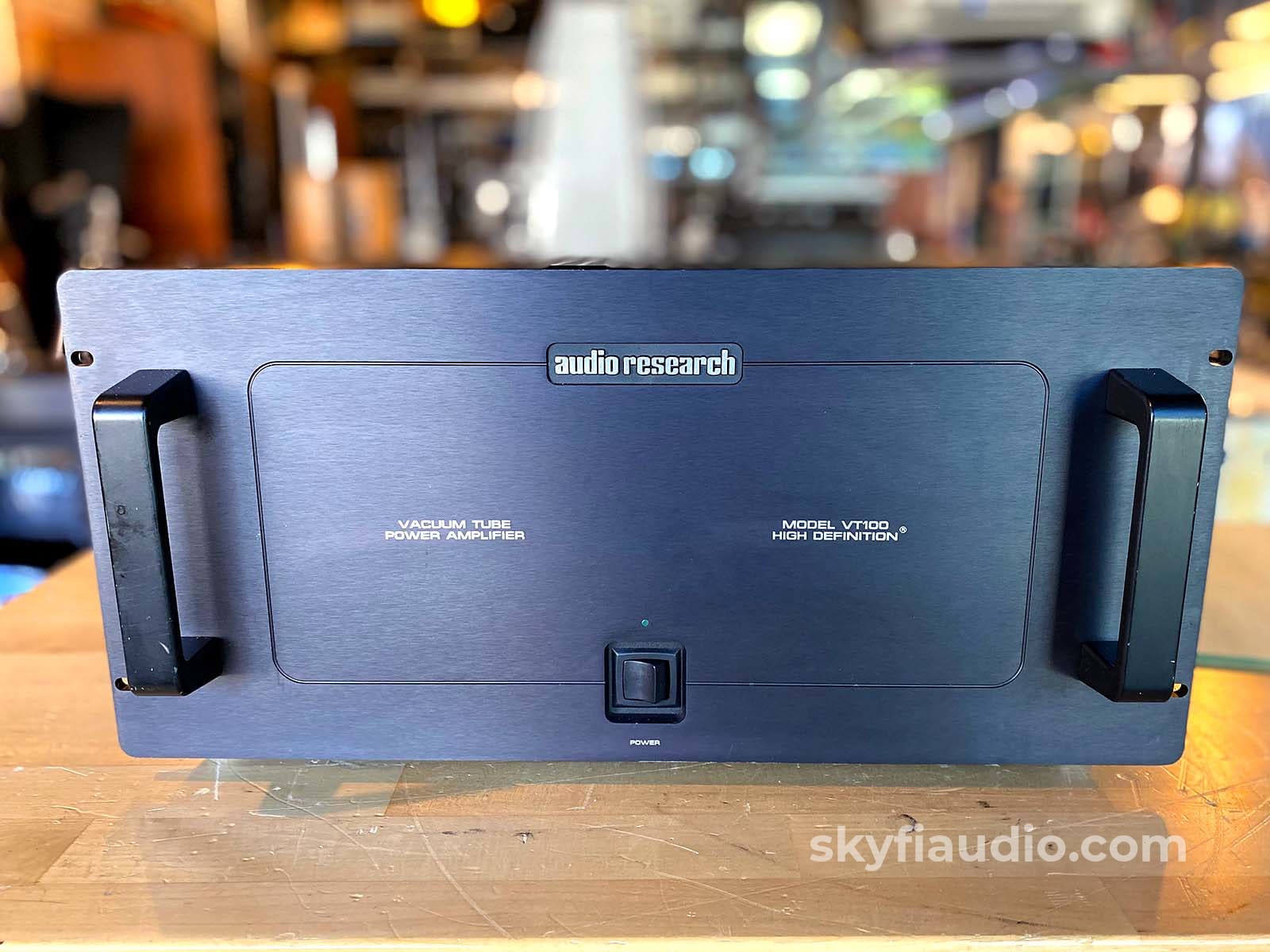
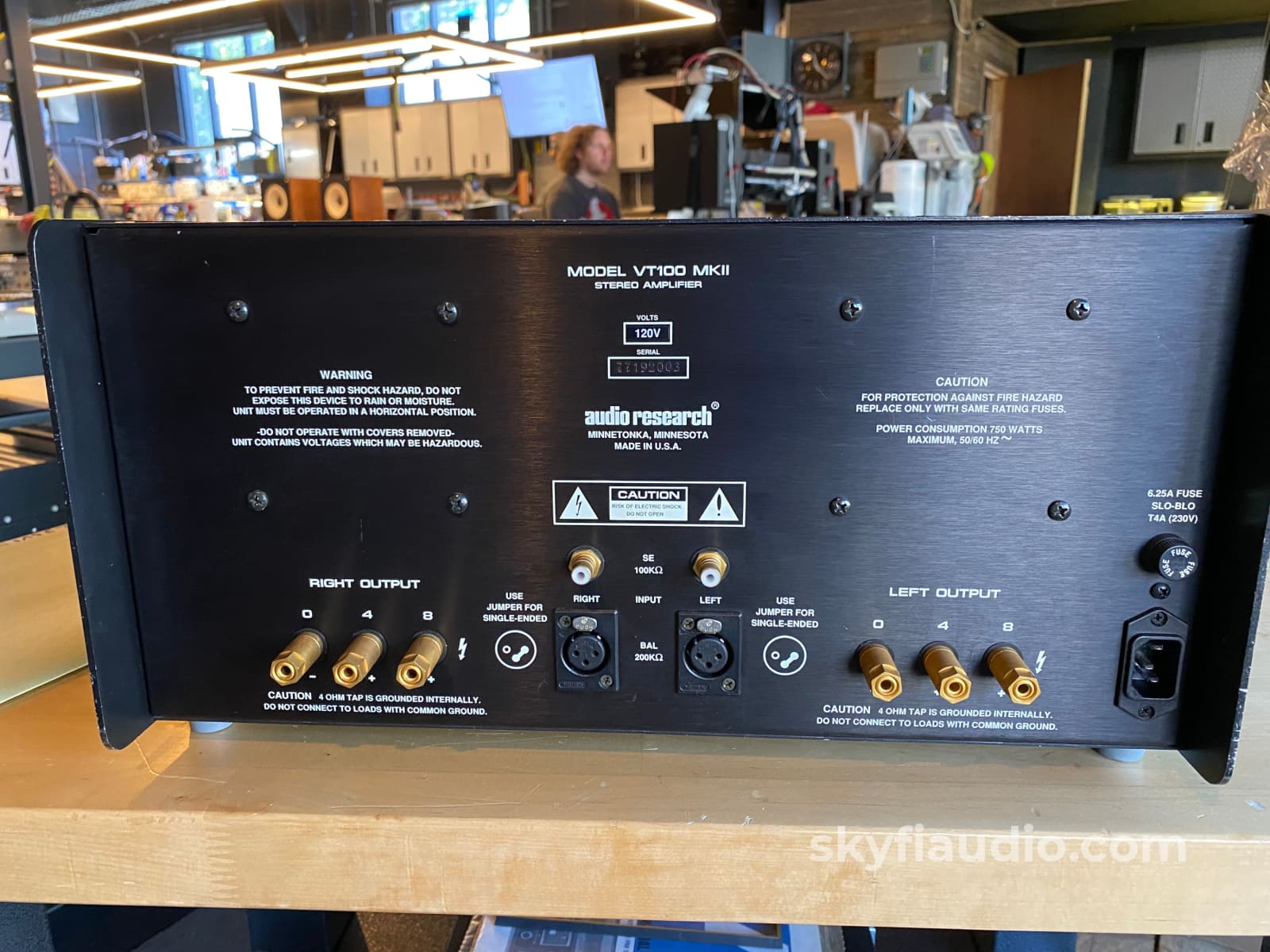
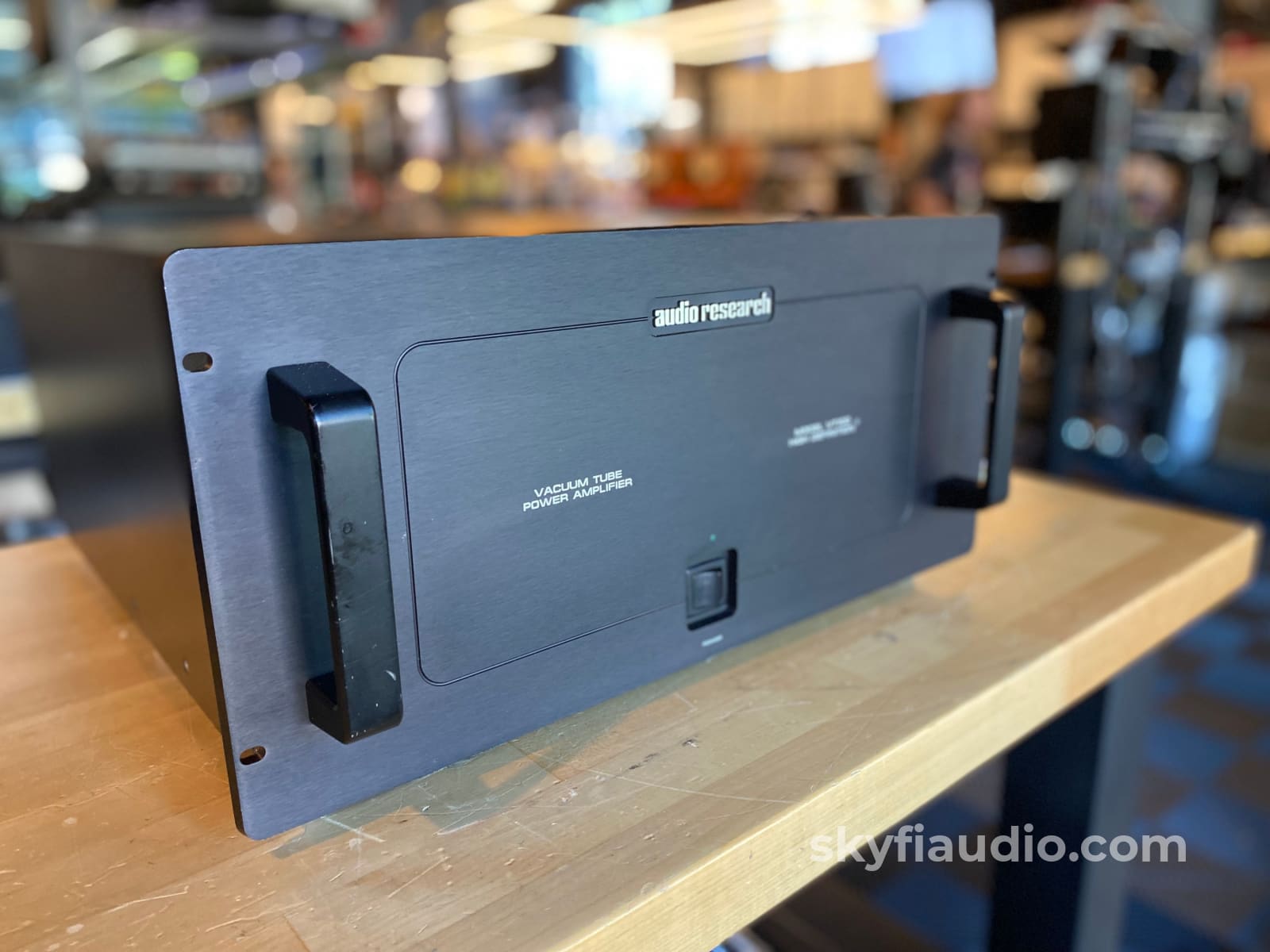
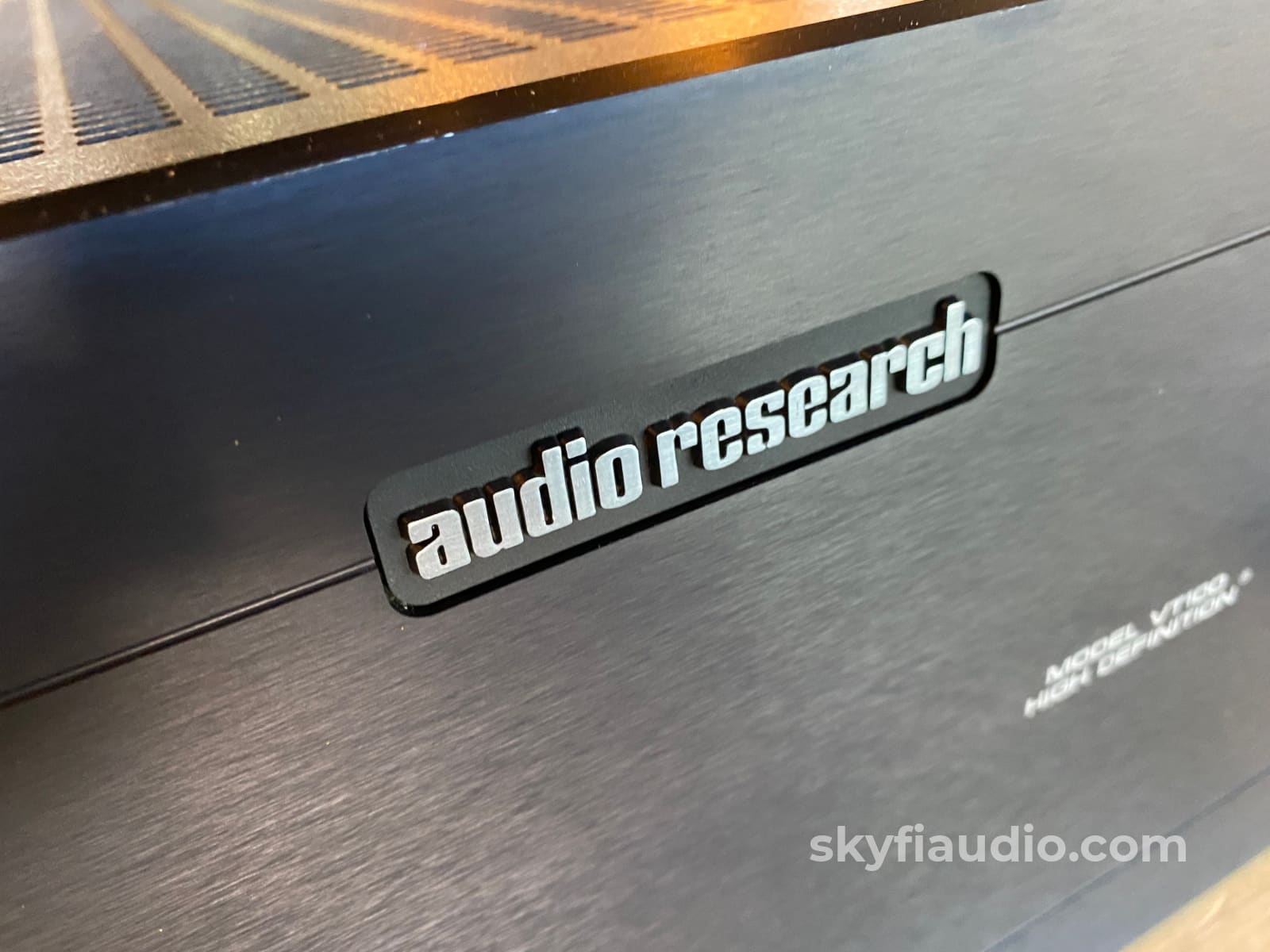
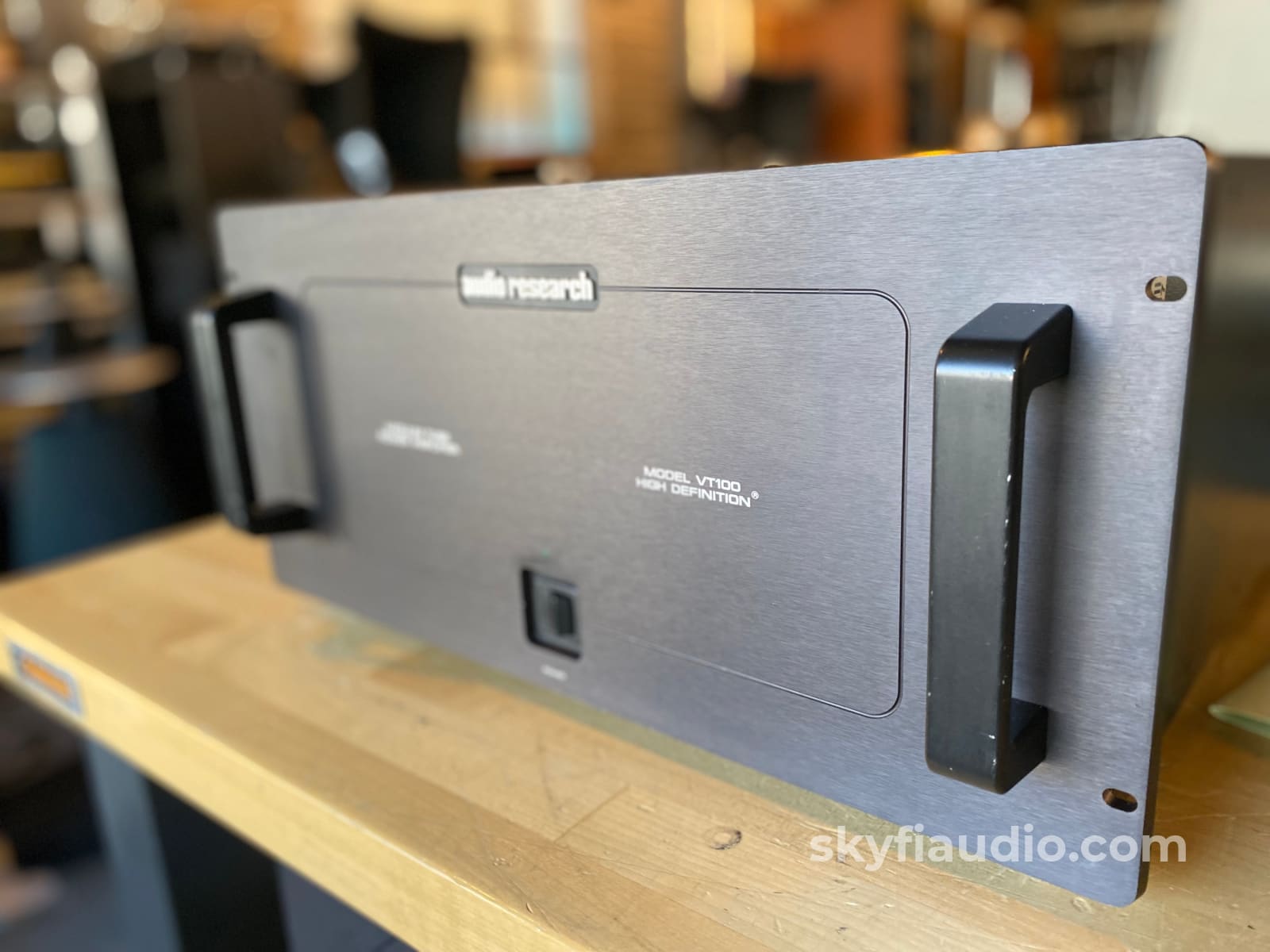

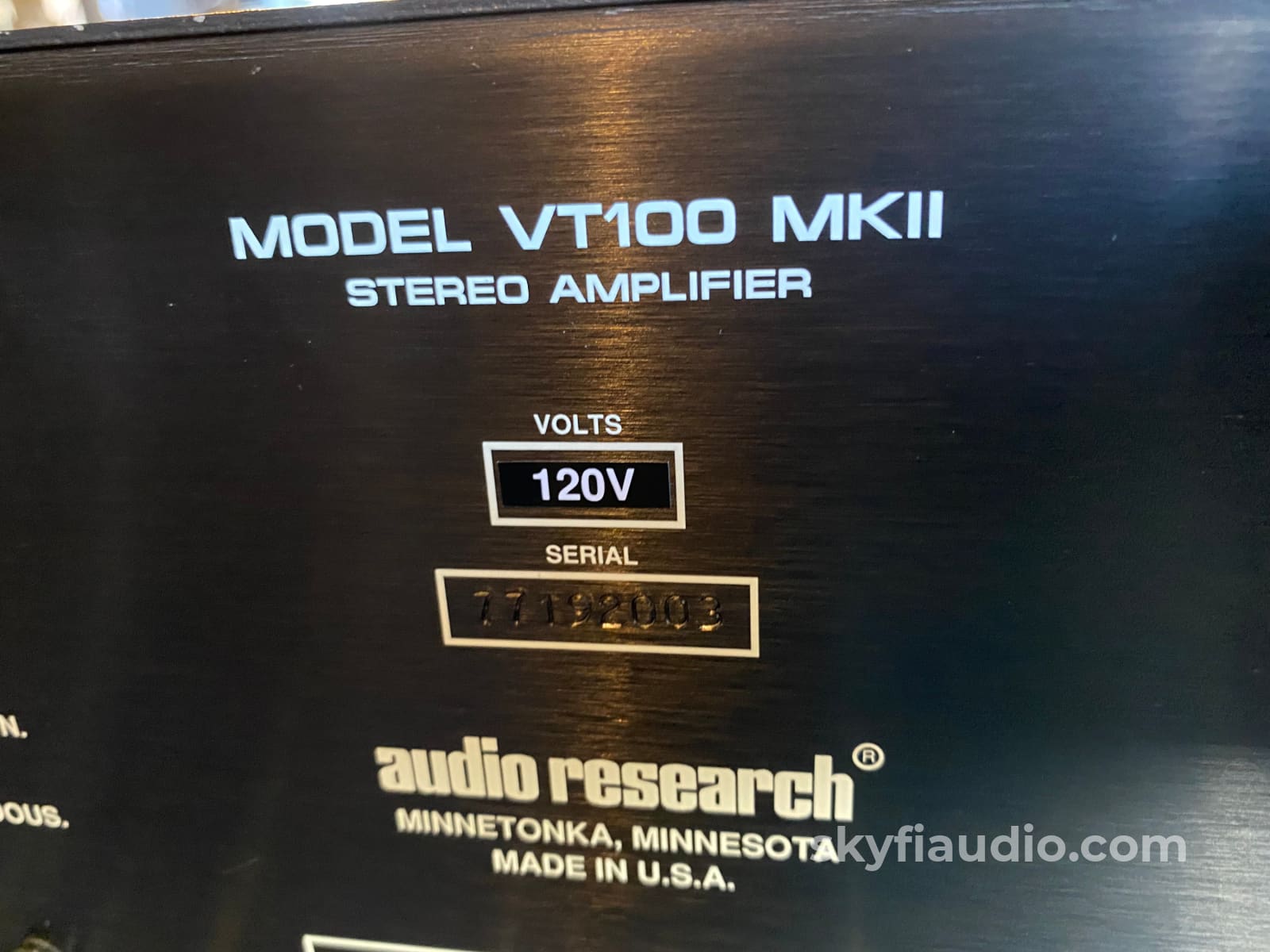
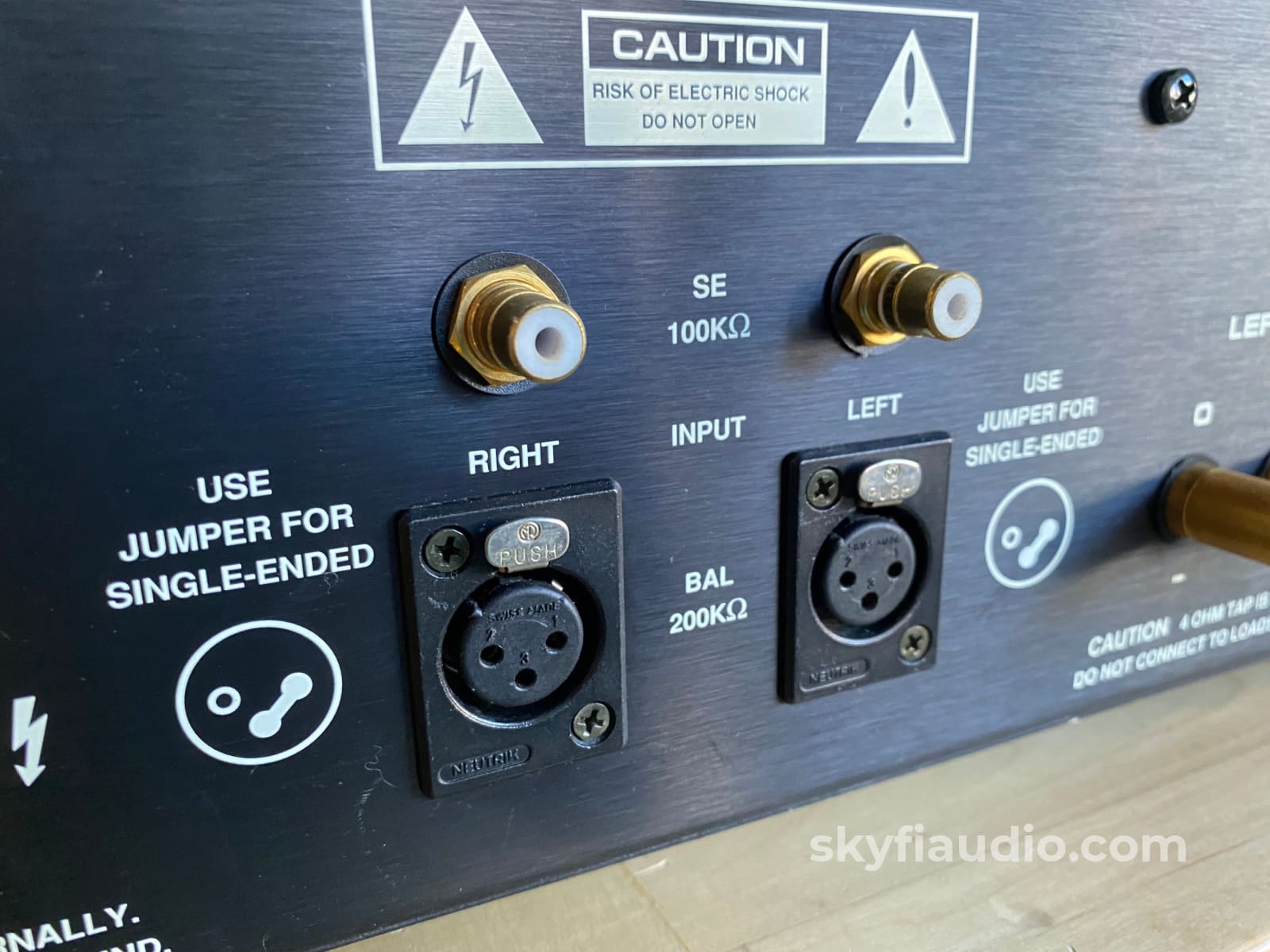

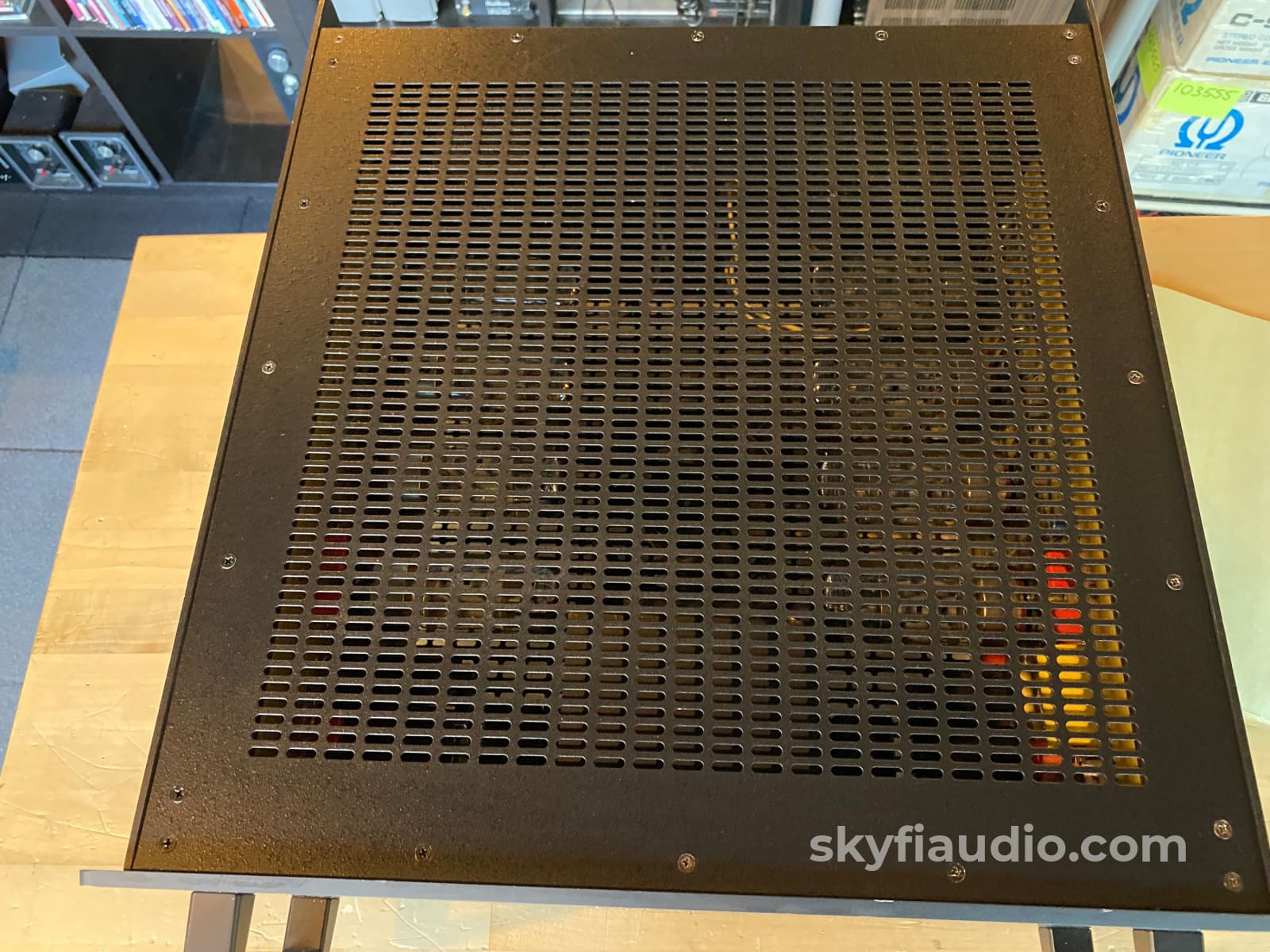
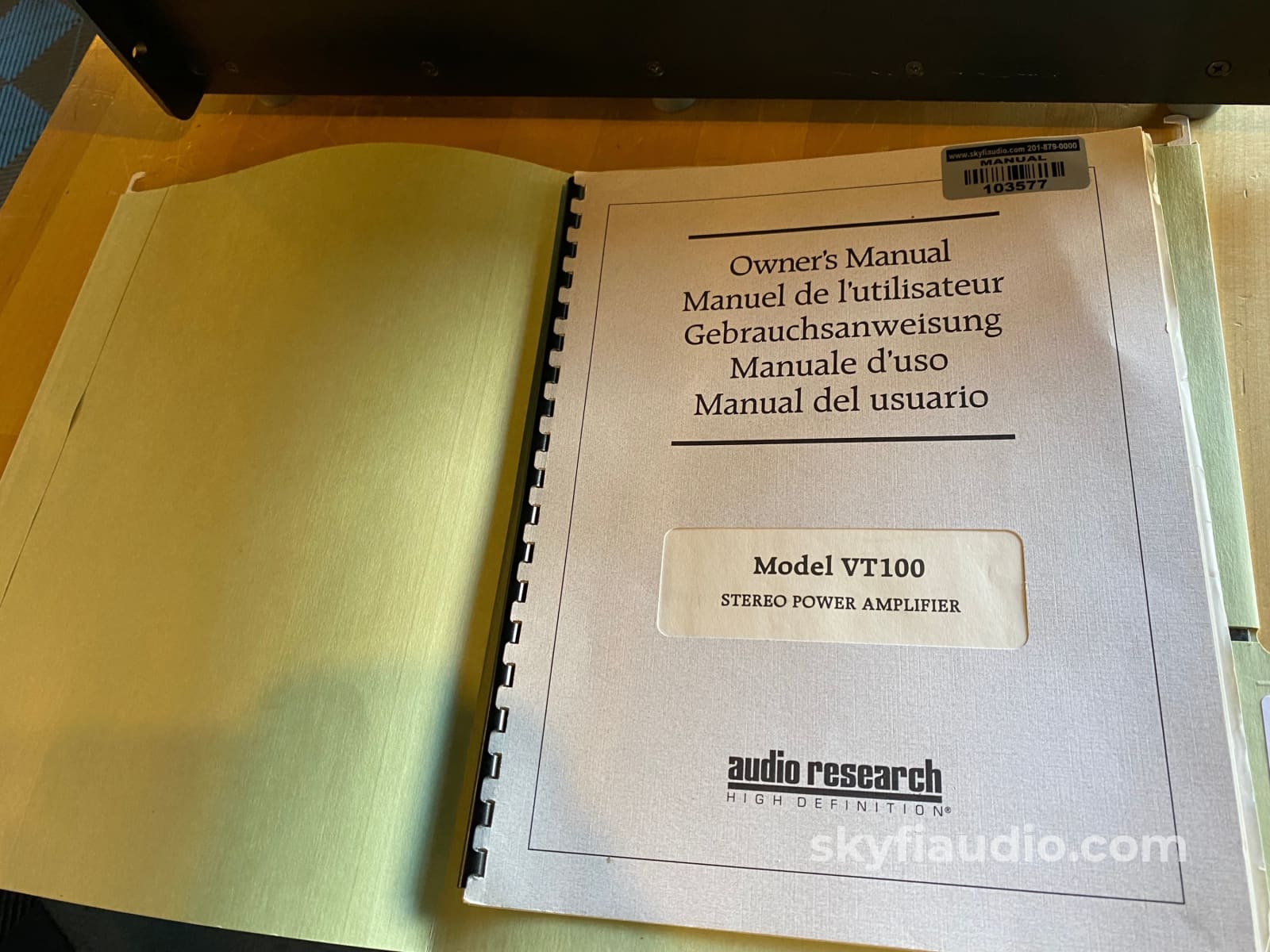
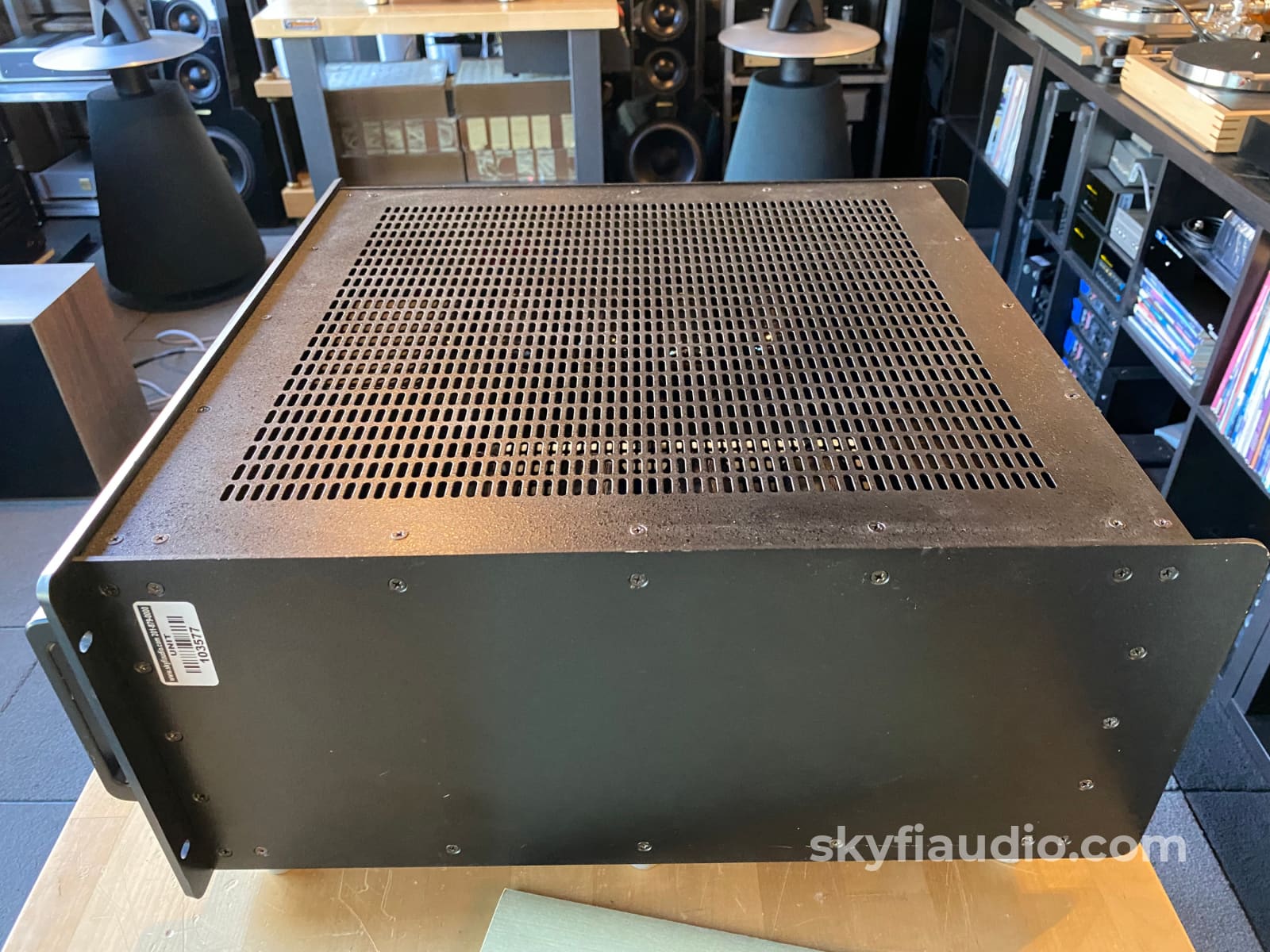
Audio Research VT100 MKII Tube Amplifier In Rare Black Finish
Free Shipping on Most Electronics - Excludes Speakers and Items Requiring Freight - Contiguous U.S. Only
Pickup currently unavailable at SkyFi 479

Audio Research VT100 MKII Tube Amplifier In Rare Black Finish
SkyFi 479
479 South Broad Street
Glen Rock NJ 07452
United States
Check out this full VT100 video review from our YouTube channel for all the design and construction details:
This particular piece is finished in the rarer and much harder to find black color.
Plus it's also the later MKII version featuring active cooling and a larger power supply.
All VT100's can be converted to native 220V if you have the knowledge. Please let us know when ordering if you'd like it reconfigured.
Good condition with some scratches and signs of use. Serviced, biased, and ready to go!
Includes the original manual and a power cord.
Tube Notes:
Driver tubes are a mix of modern Electro Harmonix 6922 and vintage Philips ECG 6922. Output tubes are two matched quads of used Svetlana Winged C 6550 (Flat Top). Driver tube adjustments and bias set to service manual spec.
The SkyFi Testing Process for Tube Amplifiers:
We start with a visual inspection of all internal components to make sure that there are no signs of heat stress or damage. Capacitors are checked for telltale signs of predictive failure including bulging, shrunken wrappers, or physical leakage. We also inspect resistors and other passive components for signs of overheating. If tube arcing has occurred in the past we can usually spot discoloration on the output tube sockets. On vintage units we often spot check select capacitors for value and ESR.
If the amplifier passes visual inspection, we move on to a full test of all of the tubes. We use an Amplitrex AT-1000 Tube Tester which is capable of testing both emission and Gm with a high degree of accuracy. We document the results of each tube and replace any weak or suspect tubes before proceeding. When we power on tube amplifiers for the first time we usually use a variac and current limited AC supply and slowly raise the voltage up to nominal mains level while monitoring plate, screen, filament, and negative bias supply voltages where applicable. If everything is in order we feed a low level test signal into the amplifier’s input and monitor its output on an oscilloscope across an 8 ohm dummy load. At this point we are just looking to verify basic function and confirm that the output transformers are not damaged. Once we have verified that the amplifier is safe to operate, we connected it to full mains power. For fixed bias amps we set the bias to manufacturer spec. For cathode biased amps we monitor the plate to cathode voltage to determine if the output tubes are operating in a safe range. Once the output section is verified we move onto bench evaluation.
We start by feeding the input of the amplifier with a low level 1KHz test signal, slowly increase its amplitude while monitoring the amplifier’s output on an oscilloscope for signs of noise, clipping, distortion, or improper channel balance. We continue increasing the signal level until the amplifier reaches clipping. At this point we take an output power measurement and compare it to the spec sheet of the amplifier to verify proper performance. We finish off the bench evaluation with a 1KHz square wave check and a 20Hz to 20KHz sine sweep to assess the amplifier’s frequency response characteristics. This battery of tests will usually reveal if the amplifier has any issues that need further attention.
Before the device leaves the bench, we perform a listening test with actual music using a variety of preferred test tracks. Our benches are outfitted with familiar monitor speakers which help us identify inconsistencies that will not always show up on our test gear. The main things that we are listening for are hum or noise with no signal present, proper center image, clicks, pops, or any other obvious undesirable audio characteristics.
If the unit passes all of these tests it is moved to our long term testing rig where we simulate real word operating conditions for 6-8 hours. For tube amps we like to run this test at least twice. This allows us to monitor the unit for signs of thermal runaway or intermittent issues that only crop up when it has fully come up to temperature. We find this step to be essential, especially for vintage units.
Click below to add our recommended matching cables from Kimber Kable, all brand new as SkyFi is an official Kimber dealer.
Ascent Series Hero Analog Interconnects (PAIR) - RCA Ultraplate or WBT Connectors
Ascent Series Hero Analog Interconnects (PAIR) - BALANCED XLR Connectors
Kimber Kable - Bi-Wire Speaker Cables
Kimber Kable - Power Cords - Better
Kimber Kable - Power Cords - Best
More from Audio Research:
The VT100 is a new all-tube, balanced stereo power amplifier that draws upon the advanced technology of the flagship Reference Series models. Rated at 100 watts continuous output per channel, the VT100 is a Class AB, differential circuit design using two matched pair of 6550 output tubes in each channel, along with four 6922 twin triodes per channel for input and driver stages. A fully regulated, 270-joule power supply is distributed between two separate, isolated output circuit boards for short signal paths and true "dual mono" operation back to the massive main power transformer. Constant-current sources in the input stage help maintain stable drive characteristics and differential balance under the dynamic conditions of music reproduction.
Ultralinear output transformers and partial cathode coupling to the output terminals give the VT100 higher efficiency and lower output impedance than conventional designs for better drive into a wide variety of loudspeaker loads. Inputs include both single ended and balanced. Output terminals are custom-machined, heavy duty, gold-over-brass posts. A spacious chassis and open internal architecture allow ample convection cooling without fans.
VT100 MKII (SPRING 1998)
The VT100MKII is a new all-tube, balanced stereo power amplifier that draws upon the advanced technology of the flagship Reference Series models. Rated at 100 watts continuous output per channel, the VT100MKII is a Class AB, differential circuit design using two matched pair of 6550 output tubes in each channel, along with four 6922 twin triodes per channel for input and driver stages. A fully regulated, 540-joule power supply is distributed between two separate, isolated output circuit boards for short signal paths and true "dual mono" operation back to the massive main power transformer. Constant-current sources in the input stage help maintain stable drive characteristics and differential balance under the dynamic conditions of music reproduction.
Ultralinear output transformers and partial cathode coupling to the output terminals give the VT100MKII higher efficiency and lower output impedance than conventional designs for better drive into a wide variety of loudspeaker loads. Inputs include both single ended and balanced. Output terminals are custom-machined, heavy duty, gold-over-brass posts. A spacious chassis and single cooling fan help maintain conservative operating temperatures.
DETAILS and SPECIFICATIONS:
Tube stereo amplifier
INTRODUCED
1996
POWER OUTPUT
100 watts minimum continuous from 20Hz to 20kHz. 1kHz total harmonic distortion typically 1% at 100 watts, below .05% at 1 watt. Approximate actual power available at "clipping": 110 watts (1kHz) (Note that the actual RMS power output is dependent upon both line voltage and "condition" ie: if power line has high distortion, maximum power will be affected adversely, although from a listening standpoint this is not very critical.)
POWER BANDWIDTH
(-3dB points) 15Hz to 80kHz.
FREQUENCY RESPONSE
(-3dB points at 1 watt) 1Hz to 100 kHz.
INPUT SENSITIVITY
1.9V RMS (Bal or SE) for rated output. (23.5 dB gain into 8 ohms.).
INPUT IMPEDANCE
200K ohms Balanced, 100K ohms Single-ended.
OUTPUT TAPS
8 ohms, 4 ohms
OUTPUT REGULATION
Approximately 0.8dB 8 ohm load to open circuit
OVERALL NEGATIVE FEEDBACK
10dB.
DAMPING FACTOR
Approximately 11
DISTORTION
1kHz total harmonic distortion typically 1% at 100 watts, below .05% at 1 watt
SLEW RATE
15 Volts/µs.
RISE TIME
3 µs. VT100 MKIII: 4 µs
HUM & NOISE
Less than 0.5mV RMS - 95dB below rated output (IHF weighted, input shorted). VT100 MKIII: Less than 0.2mV RMS - 103dB below rated output (IHF weighted, Bal input shorted)
POWER SUPPLY ENERGY STORAGE
VT100 MKII/III: 540 joules
POWER REQUIREMENTS
VT100 MKII/III: 105-125VAC 60Hz (210-250VAC 50Hz) 650 watts at rated output, 800 watts maximum, 440 watts at "idle"
TUBE COMPLEMENT
VT100 MKII: (4 matched pairs) 6550C power output, (4) 6922 driver, (4) 6922 input.
DIMENSIONS
19" (48.3 cm) W x 8 ¾" (22.2 cm) H x 19½" (49.5 cm) D. Handles extend 1½" (3.8 cm) forward
WEIGHT
VT100 MKII: 66.7 lbs. (30.3 kg) Net; 83.7 lbs. (38.0 kg) Shipping.
|
Item |
Included |
|
Original Box |
Not Included |
|
Manual |
Yes Included |
|
Remote |
Not Applicable |
|
Cables |
Yes - Power Only |
|
Physical Condition |
8 / 10 |
|
Working Condition |
10 / 10 |
Choose options
